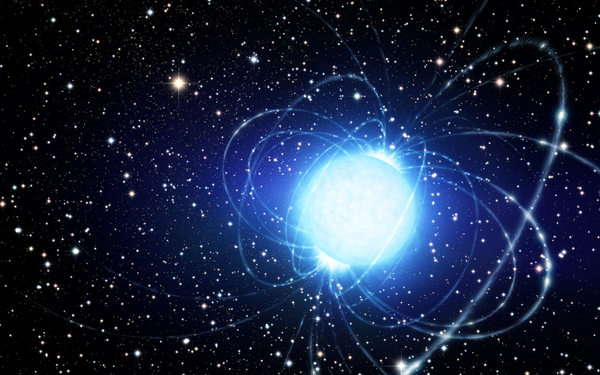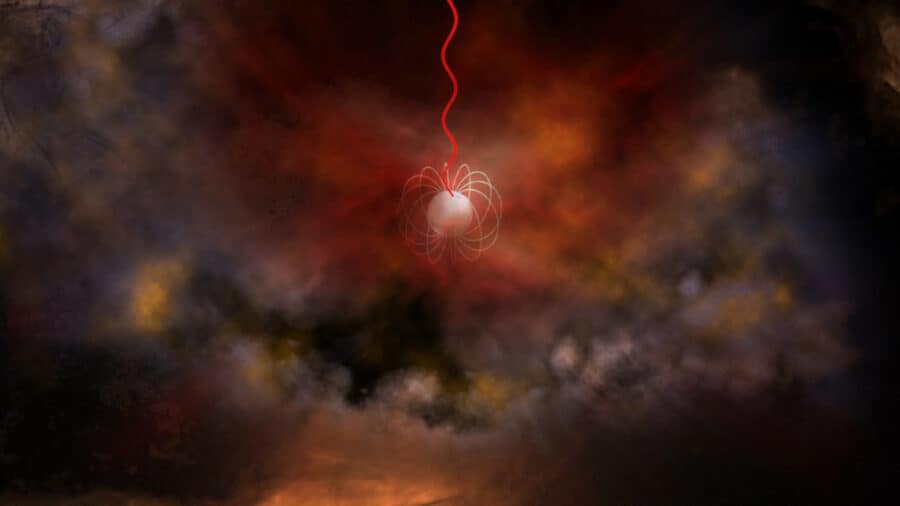Black holes are collapsed stars with immense gravity, while magnetars are highly magnetized neutron stars. Both are astrophysical phenomena with unique characteristics.
Black holes are known for their ability to trap light due to their gravitational pull, while magnetars exhibit incredibly strong magnetic fields. Understanding the differences and similarities between these two objects can provide valuable insights into the nature of the universe and the extreme forces at play in outer space.
Let’s explore the fascinating world of black holes and magnetars to uncover their mysteries and significance in the cosmos.

Credit: www.astronomy.com
2. What Is A Black Hole?
2. What is a Black Hole?
A Black Hole is a region in space where the gravitational pull is so intense that nothing, not even light, can escape from it.
2.1 Formation
Black Holes form when massive stars collapse under their weight after exhausting their nuclear fuel.
2.2 Characteristics
A Black Hole has an extremely dense core called a singularity and is surrounded by an event horizon.
2.3 Event Horizon
The Event Horizon is the point of no return around a Black Hole where nothing can escape its gravitational pull.
3. What Is A Magnetar?
Magnetars are incredibly fascinating astronomical objects known for their intense magnetic fields. These are neutron stars, which are remnants of massive stars that have exploded in supernova events.
3.1 Formation
Neutron stars are formed when the core of a massive star collapses under its gravity during a supernova explosion.
3.2 Characteristics
- Magnetars are extremely dense and have a mass greater than the Sun but are only about 10-15 kilometers in diameter.
- They spin rapidly, with some magnetars rotating hundreds of times per second.
- Their magnetic fields are some of the strongest in the universe, reaching magnitudes billions of times greater than Earth’s magnetic field.
3.3 Strong Magnetic Fields
Magnetars are known for their incredibly strong magnetic fields, which can cause dramatic and violent events in their vicinity. These magnetic fields can distort the shape of the magnetar and lead to powerful bursts of X-rays and gamma rays.
4. Differences Between Black Holes And Magnetars
Black holes and magnetars are fascinating celestial objects that exhibit extreme properties. While both are incredibly dense and possess a strong gravitational force, there are several key differences between them. Let’s explore the contrasting characteristics of black holes and magnetars.
4.1 Gravitational Force
Gravitational force, a fundamental property of celestial bodies, plays a crucial role in distinguishing black holes from magnetars. Black holes, known for their immense gravitational pull, have a gravitational force beyond comprehension due to their infinitely small size and tremendous mass.
On the other hand, magnetars, which are highly magnetized neutron stars, also generate a substantial gravitational force. However, their gravitational pull is not as intense as that of black holes, as magnetars’ mass is relatively smaller compared to black holes.
4.2 Magnetic Fields
Magnetic fields, another significant factor in differentiating black holes from magnetars, have a substantial impact on their behavior. While black holes possess magnetic fields, they are relatively weak compared to magnetars. Magnetars, as their name suggests, have an incredibly strong magnetic field, billions of times more powerful than Earth’s magnetic field.
This intense magnetic field in magnetars leads to the emission of high-energy particles and bursts of radiation, causing them to be highly active astronomical objects. In contrast, black holes’ weaker magnetic fields do not result in notable electromagnetic activity.
4.3 Mass And Density
Mass and density are vital aspects when comparing black holes and magnetars. Black holes, formed by the gravitational collapse of massive stars, boast an extraordinary amount of mass packed into a singularity, resulting in mind-boggling density.
In contrast, magnetars, remnants of supernova explosions, have a relatively lower mass compared to black holes. However, what magnetars lack in mass, they compensate for with their incredibly high density, where a teaspoon of material from a magnetar would weigh as much as a mountain on Earth.
Table: Comparing Mass and Density of Black Holes and Magnetars:
| Mass (Solar Masses) | Density (g/cm³) | |
|---|---|---|
| Black Holes | Varies, typically several times that of the Sun | Extremely high, near infinity |
| Magnetars | 1.4 – 3 times that of the Sun | Enormous, teaspoonful weighs billions of tons |
In conclusion, while both black holes and magnetars possess strong gravitational forces, the differing strengths of their magnetic fields, mass, and density set them apart. Understanding these variations provides astronomers with valuable insights into the extraordinary and enigmatic nature of these celestial objects.

Credit: www.manticgames.com
5. Similarities Between Black Holes And Magnetars
When exploring the universe, the similarities between black holes and magnetars are striking. Both are fascinating celestial bodies that pose intriguing questions for scientists. In this section, we will delve into the key similarities between black holes and magnetars, shedding light on their compactness and stellar origins.
5.1 Compactness
Black holes and magnetars are defined by their remarkable compactness. A black hole’s gravitational pull is so strong that nothing, not even light, can escape its grasp. Similarly, a magnetar’s magnetism is incredibly intense, leading to extreme compression of its mass. This exceptional compactness distinguishes these celestial entities and captivates astronomers and physicists alike.
5.2 Stellar Origins
Both black holes and magnetars have intriguing stellar origins. Black holes form when massive stars undergo gravitational collapse at the end of their lifecycle, leading to an infinitely dense singularity. In contrast, magnetars are born from the remnants of supernova explosions, resulting in the transformation of a star’s core into an intensely magnetized neutron star. These diverse yet enthralling stellar origins contribute to the enigmatic nature of both black holes and magnetars.
6. Extreme Phenomena Associated With Black Holes
When it comes to extreme phenomena associated with black holes, the mind boggles at the sheer magnitude of the events that occur in their vicinity.
6.1 Hawking Radiation
Hawking radiation refers to the theoretical radiation that black holes emit due to quantum effects near the event horizon. This phenomenon was proposed by physicist Stephen Hawking in 1974, revolutionizing our understanding of black holes.
6.2 Spaghettification
Spaghettification occurs when an object approaches the event horizon of a black hole. The intense gravitational forces at this boundary stretch the object into long, thin strands, resembling spaghetti. This process is a consequence of extreme tidal forces near black holes.
6.3 Time Dilation
Time dilation near black holes is a mind-bending concept. As an object approaches the event horizon, time passes more slowly for an observer far from the black hole. This phenomenon is a result of the intense gravitational pull of the black hole affecting the flow of time itself.
7. Extreme Phenomena Associated With Magnetars
Undoubtedly, magnetars are some of the most intriguing and powerful celestial objects in the universe. They possess incredibly strong magnetic fields and are known for their extreme behaviors and phenomena. In this section, we will explore three specific phenomena commonly associated with magnetars: starquakes, gamma-ray bursts, and magnetospheric activity.
7.1 Starquakes
Magnetars, due to their immense magnetic fields, experience a phenomenon known as “starquakes.” These starquakes are seismic activities that occur on the surface of the magnetar, causing it to vibrate and release tremendous amounts of energy.
During a starquake, the magnetar’s magnetic field interacts with the crust, causing it to crack and rupture. The resulting release of energy can be so powerful that it rivals the energy emitted by an entire galaxy!
These starquakes generate intense bursts of X-rays and gamma rays, which are detectable from Earth. Studying these starquakes allows scientists to gain insights into the fascinating internal structure and dynamics of these extraordinary celestial objects.
7.2 Gamma-ray Bursts
Gamma-ray bursts (GRBs) are highly energetic and brief bursts of gamma rays, often originating from distant galaxies. While magnetars are not the sole progenitors of GRBs, they are believed to be one possible source for these spectacular cosmic phenomena.
When a magnetar experiences a starquake, it releases an enormous amount of energy, including a significant portion in the form of gamma rays. If this emission is directed towards Earth, it can be detected and observed as a gamma-ray burst.
GRBs are considered some of the most powerful events in the universe, spanning just a few seconds but releasing more energy than our Sun will emit throughout its entire lifetime. Scientists continue to study magnetars and their association with GRBs to unravel the mysteries behind these colossal cosmic explosions.
7.3 Magnetospheric Activity
Magnetospheric activity refers to the fascinating phenomena that occur within the magnetosphere of a magnetar. The magnetosphere is the region surrounding the celestial object that is influenced and shaped by its magnetic field.
Due to the extreme strength of a magnetar’s magnetic field, the magnetosphere undergoes intricate and complex processes. These processes include particle acceleration, magnetic reconnections, and the formation of intense radiation belts.
The magnetosphere of a magnetar is a dynamic environment, constantly changing and evolving as the celestial body interacts with its surroundings. Understanding magnetospheric activity provides deep insights into the intricate interplay between magnetic fields and the high-energy particles near these exotic objects.

Credit: www.dailymail.co.uk
Frequently Asked Questions On Black Hole Vs Magnetar
What Is The Difference Between A Black Hole And A Magnetar?
A Black Hole is formed from the collapse of a massive star, while a Magnetar is a type of neutron star with an extremely powerful magnetic field. Both are remnants of supernova explosions but with distinct characteristics.
What Are The Gravitational Properties Of Black Holes And Magnetars?
Black Holes have an immense gravitational pull that even light cannot escape, while Magnetars have strong magnetic fields that can distort the properties of nearby objects, including light.
How Do Black Holes And Magnetars Affect Their Surrounding Environments?
Black Holes consume nearby matter and emit powerful radiation, altering cosmic surroundings. Magnetars release bursts of X-rays and gamma rays, impacting their surroundings and potentially triggering phenomena like starquakes.
Conclusion
The comparison between black holes and magnetars unveils striking differences and unique attributes of these celestial phenomena. While black holes possess immense gravitational pull and are notorious for their ability to devour everything in their path, magnetars exhibit astonishing levels of magnetic fields, resulting in powerful bursts of energy.
Exploring the characteristics of these cosmic entities expands our understanding of the diverse wonders of the universe and raises intriguing questions yet to be answered.



